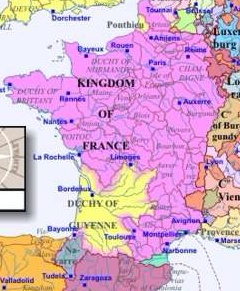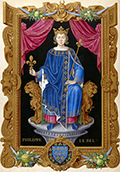The French King Philip IV
Part 1: Building Influence
Philip was born at the Palace of Fontainebleau in the spring of 1268, when his grandfather, Louis IX, was on the throne of France and his father, Philip, was the heir to the throne. Louis IX died in 1270, and Philip became King Philip III. Louis IX had died while on the Seventh Crusade. His son, Philip, and Philip's wife, Isabella of Aragon, had accompanied the king to Tunis. Philip returned to France to take the throne, but Isabella did not survive the trip. Isabella's three children were young and motherless, and young Philip, especially, struggled through the next several years. Philip III married again in 1274, to Marie de Brabant. In that same year, a young girl named Joan of Navarre came to court. She grew up with the royal children. Young Philip, known as Philip the Fair, was second-in-line to the throne because he had an older brother, named Louis. When the heir apparent died in 1276, young Philip became heir to the throne. Thus, when his father died in 1285, Philip ascended the throne as King Philip IV. 
Philip had married Joan of Navarre the year before, bringing her territory into the royal fold, along with Champagne and Brie. By the time that Philip III died, he had acquired quite a bit of territory, including Lyons, Poitiers, and Toulouse. Philip and Joan had seven children together. Those who survived into adulthood were Louis, Philip, Charles, and Isabella. The boys all became King of France; the girl became Queen of England. Joan died in 1305, and Philip did not remarry. The kings of England for a century or so had also claimed the title of Duke of Aquitaine, as a result of England's King Henry II's marriage to Eleanor of Aquitaine in 1152. A dispute in Gascony, part of Aquitaine, escalated in 1294 into war between England and France. It was during this war that France and Scotland began the Auld Alliance, a long-running mutual defense pact against England. The 1303 treaty that ended the on-again-off-again conflict restored Gascony to England; sealing the deal was a royal marriage, of Edward, the son of England's King Edward I to Isabella, Philip IV's daughter. In the midst of this war, Guy of Dampierre, Count of Flanders, had thrown in his lot with England, angering Philip and France. As the war with England was winding down, Philip sent a strong force to fight against the Flemish. The Battle of the Golden Spurs in 1302 resulted in a resounding Flemish victory. Undaunted, Philip pressed on, turning the tables and thrashing the Flemish two years later, personally leading the troops at Mons-en-Pé/vèle. The resulting peace in 1305 fell heavily in Philip's favor. Next page > French Supremacy > Page 1, 2 |
|
Social Studies for Kids
copyright 2002–2025
David White



 Philip IV was one of the more controversial and well-known Kings of France in the 13th Century, enlarging the royal holdings at the expense of several enemies and embarking on a handful of wars that all but bankrupted his government. He is perhaps most well-known for initiating the Avignon Papacy, a decadeslong "residency" of the popes in France, and for destroying the Knights Templar.
Philip IV was one of the more controversial and well-known Kings of France in the 13th Century, enlarging the royal holdings at the expense of several enemies and embarking on a handful of wars that all but bankrupted his government. He is perhaps most well-known for initiating the Avignon Papacy, a decadeslong "residency" of the popes in France, and for destroying the Knights Templar.
